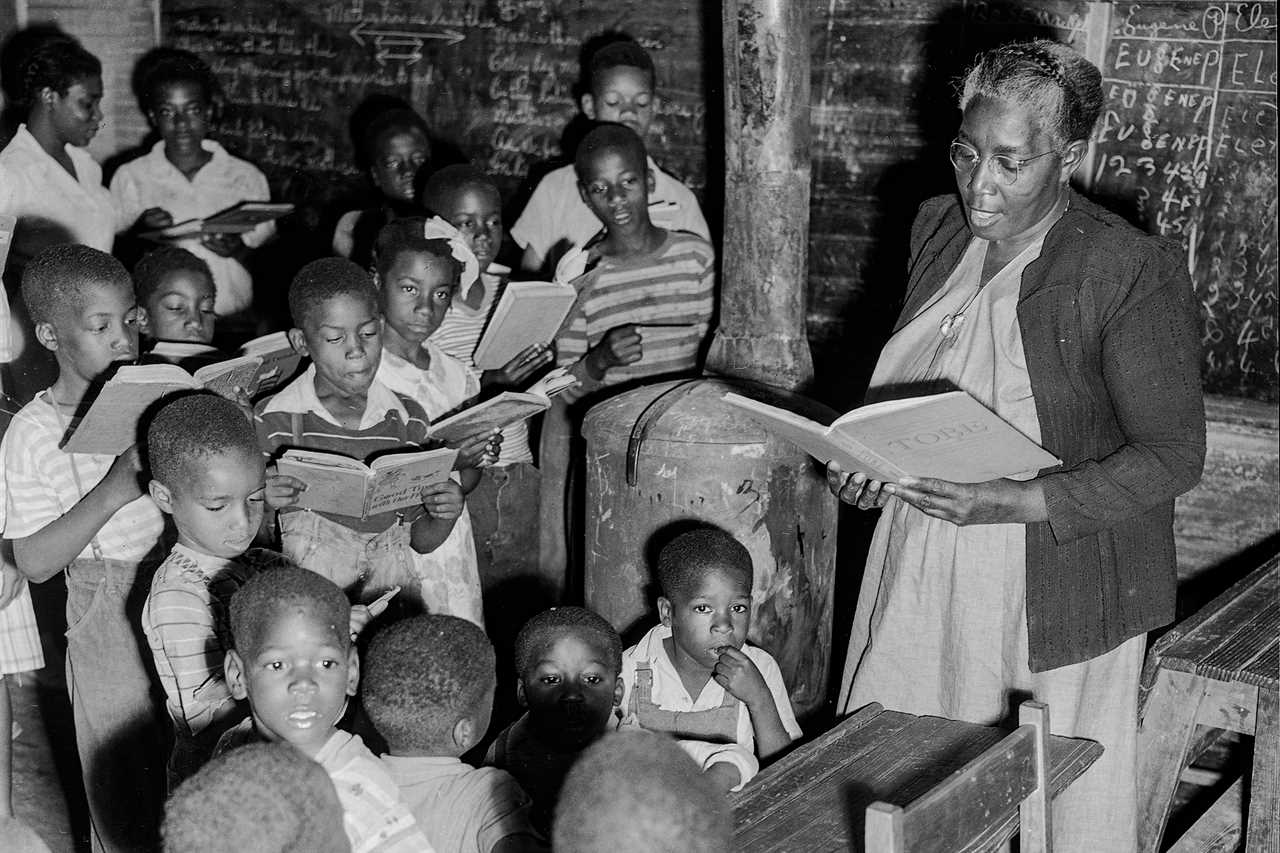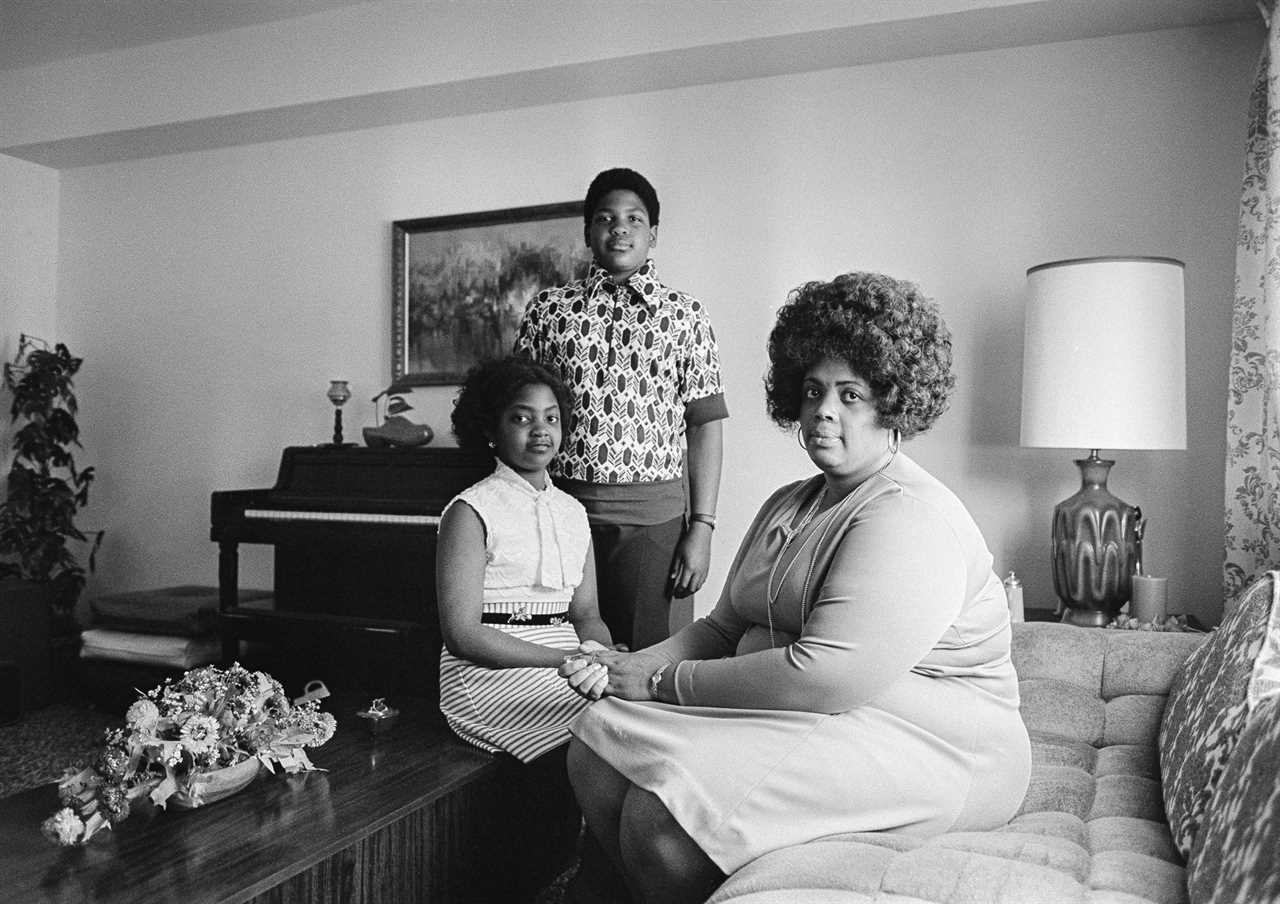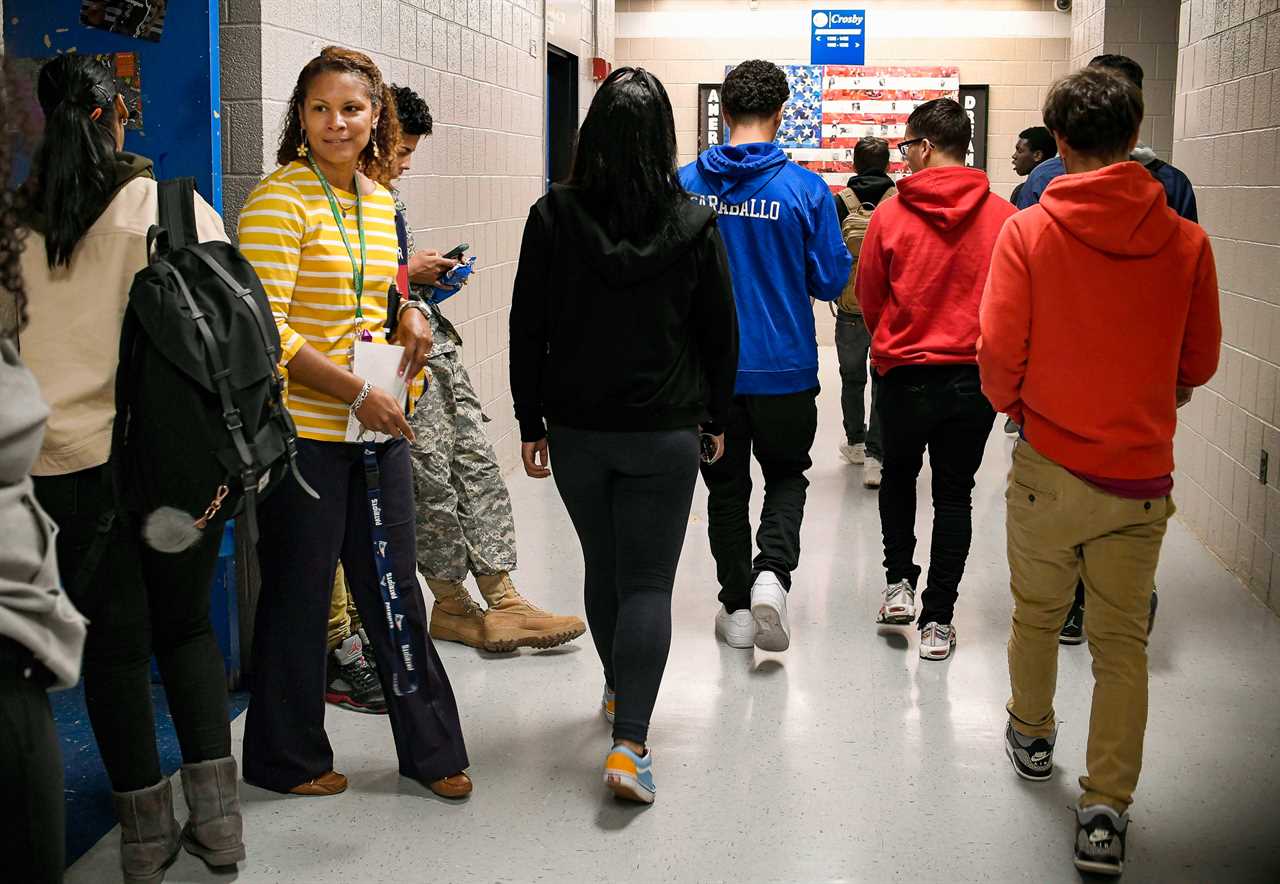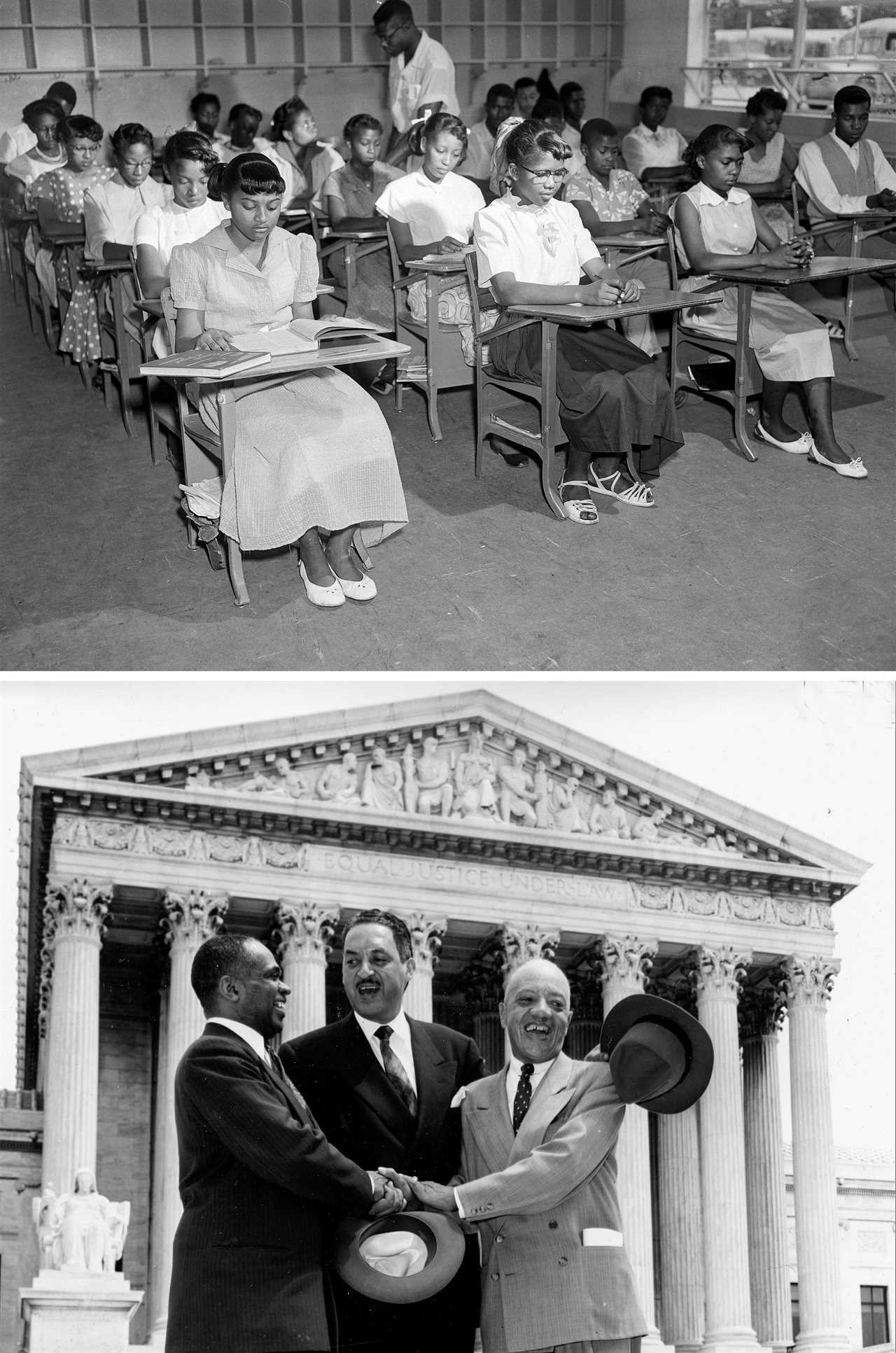
Today, most Americans think about the segregation-shattering 1954 Brown v. Board of Education decision in one of three ways. We may think about Linda Brown, the plaintiff in Brown, a little girl forced to walk miles to a segregated Black school instead of attending the white school down the block. We may remember the famed Norman Rockwell painting featuring 6-year-old Ruby Bridges escorted by U.S. Marshals past a wall splattered with tomatoes and a racial slur. Or we may recall the tumult of busing in the South — Alabama, Mississippi, and Georgia… and even much further north of the Mason-Dixon Line in South Boston, too.
But there is plenty that we have not been taught about Brown, which turns 68 today, or how it continues to impact us. We know about Linda Brown and Ruby Bridges. But we don’t know about Pressley Giles, Mary Preyer, Virgil Coleman and Jewel Butler. They were among the 100,000 exceptionally credentialed Black principals and teachers illegally purged from desegregating schools in the wake of Brown.
In the years following the Supreme Court ruling, and well into the 1970s, white resistance to the decree decimated the ranks of Black principals and teachers. In large measure, white school boards, superintendents, state legislators — and white parents — did not want Black children attending school with white children. And they certainly did not want Black teachers educating white children and Black principals leading schools and supervising white teachers. The scheme devised to quickly eliminate Black educators: the closure of Black schools. Even prior to Black school closures, black principals and teachers received letters from district superintendents erroneously telling them that the desegregation decree was responsible for their firings, dismissals and demotions. Less-qualified white teachers, many of whom didn’t have credentials, were hired in their stead.
As early as 1952, NAACP attorney Thurgood Marshall knew that Black educators' jobs would be threatened given the racist strictures and customs of the Southern and border states. He was correct. After Brown, the NAACP litigated thousands of cases on behalf of displaced Black educators and pressured the Nixon administration, the U.S. Department of Justice, U.S. Department of Health, Education and Welfare, the FBI and Congress to investigate and remedy the illegal and discriminatory treatment of Black principals and teachers. Though some litigants prevailed winning back pay and reinstatement, most never got their jobs back.
Today, the nation, not to mention our public education system, is still living with the fallout: traumatized Black school children; roughly $1-2 billion in salary losses and the largest orchestrated brain drain ever experienced in the U.S. public education system. What’s more, many of the beliefs and levers that were used to eliminate Black principals and teacher leadership after Brown are still in effect today. When I read and watch contemporary news accounts of (mainly white) parents objecting to the teaching of Black history and a more truthful accounting of American history; threatening to burn books; and physically intimidating school board members, I think about resistance to the Brown legal decision. The tactics being used now come from the exact same script.

In conducting research for my new book, Jim Crow’s Pink Slip: The Untold Story of Black Principal and Teacher Leadership, I discovered the purging of Black educators happened even though Black principals and teachers were more qualified than the white educators who replaced them. Proven Black principals and teachers were replaced on a near one-to-one basis with whites who held fewer or no qualifications. Even in segregated all-Black schools, Black educators were more likely to hold bachelor’s, master’s and doctoral degrees, certification, and higher levels of licensure than their white peers. Yet after Brown, they were deemed unfit to teach white students for racist reasons, losing both their jobs and their ability to directly influence education policy and practice.
The loss inflicted four traumas still felt today. The first trauma was economic. As I estimate in my book, the low end of calculated salary losses is about $250 million for elimination of 30,000 Black educators’ jobs. Over time, 100,000 Black principals and teachers were shunted off the payrolls due to white resistance to Brown, leaving Black educators nearly $1 billion poorer. Adding to the salary losses from firings were those induced from lack of hiring. Between 1968 and 1971 alone, a total of 23,000 new principal and teaching jobs were created in 11 southeastern states. Black educators were placed in fewer than 500 of these new jobs. In these post-Brown firing and hiring equations, Black educators were desegregation’s prey and white educators its beneficiaries. They lost their jobs — and they were blocked from newly created positions producing income losses and wealth transfers from Black people to white people totaling approximately $2.2 billion today.
The second trauma was the damage done to school systems because of the loss of a high-caliber principal and teacher workforce. The mass exodus of Black teachers and principals yielded school systems led by racist fearmongers manipulating the system to maintain white power and jobs at the expense of Black people. The assault on the professional stature of Black educators ensured that the desegregated school system would be held captive by the same Jim Crow power structure that had fought vehemently against desegregation for decades.
The third trauma resulted in the “near total disintegration of Black authority in every area of public education,” according to a 1972 report by the National Education Association. That served to greatly diminish the aspirations of Black educators and young people. It is reasonable to conclude that Black youth observing the fate of their elders, would worry (and be advised) that they would have limited futures as principals and teachers. The loss of leadership symbols, success symbols and symbols of aspiration were known and felt in the Black community.
The fourth trauma was the cruelest cut of all. If schooling is about the children, as all the sentimental slogans profess, Black children did not seem to count. Ushered into “integrated” schools without Black models of intellectual authority who could serve as guides and protectors, Black students were subjected to physical violence and emotional abuse, racial intimidation and hostility and illegal suspensions, according to numerous reports by the National Education Association and the American Friends Service Committee, a human and civil rights organization. In 1965 Time magazine published an article about the firings, quoting then-U.S. Commissioner of Education Francis Keppel, who said, “We must not deceive ourselves that the exclusion of Negroes is not noticed by children. What can they assume but that the Negroes are not deemed by the community as worthy of a place in mixed classrooms? What can the white child assume but that he is somehow special and exclusive…How can the world of democracy have meaning to such children?” Even today, public school students of all races are taught curriculums that are nearly all-white in content, imagery and authorship.
We think about Brown as ancient history. It’s not. School segregation was still in full effect well into the late 1970s and early 1980s. At some point in their histories even those non-Southern states that we today categorize as liberal leaning had laws prohibiting the education of Black and white students together, including California, Iowa and Ohio, among others. At least 17 states fought with all their might against Brown for more than 20 years. In Alabama, Arkansas, Delaware, Florida, Georgia, Kansas, Kentucky, Louisiana, Maryland, Mississippi, Missouri, North Carolina, Oklahoma, South Carolina, Texas, Virginia, and West Virginia, all that might include outright law-defying governors, state legislatures, local school boards and superintendents, and white citizens groups that illegally hijacked state budgets and statutes to steer tax dollars and white students away from desegregating schools.
Most folks don’t want to talk about failures and failings. Americans especially seem to prefer stories about the triumphant underdog, the up-by-my-own-bootstraps tale, and any narrative that advances an American exceptionalism void of evil intent and outcomes. It is this psychological persuasion that keeps the nation falling into the racial sinkholes that some would like to pave over, but never excavate to resolve and seal. The American myth histories that we are taught, and our schoolbooks tell, are filled with outright lies, as our (mis)understandings about Brown exemplify. So, what’s not true that we think is true about Brown? And why does any of this matter in 2022?

The Brown decision proclaimed that racial segregation had no place in America’s public schools. It did not mandate that all-Black schools had to be shuttered and closed and that all-white schools were to be the singular recipient of integrating student bodies — but that’s what happened. White officials and citizens orchestrated this outcome as they aggressively, openly and illegally defied the new law of the land.
The Black educators who were demoted and dismissed had played by the rules. Many, if not most, attended historically Black colleges and universities because state laws restricted their attendance at white-reserved public colleges and universities, including graduate and professional schools. Even still, after earning degrees at HBCUs, thousands attended graduate school programs, earning master’s and doctoral degrees, not in their segregated home states, but in nationally prominent, Northern universities — mainly Columbia University, New York University, the University of Chicago, the University of Michigan, Ohio State University and Iowa State University. They then returned to serve as principals and teachers in segregated Black schools completing an academic migration back to their home states.
The mass closure of Black schools and influx of Black students into previously all-white schools led to an increased need for principals and teachers in desegregating schools. With Black principals and teachers pushed out, white superintendents and school boards found themselves in a quandary: Who was going to lead the schools and teach the swelling numbers of students? Pressed by the need to hire more educators, they manufactured principal and teacher shortages, turning almost exclusively to whites outside the profession, vacating state requirements for education degrees and teacher licensure, and creating fast tracks into the classroom through emergency certification. The NAACP and National Association of Secondary School Principals reported as late as 1971 that Black principals and teachers who held certification and years of experience were being replaced by white principals and teachers who had no certification and no experience in the communities in which they were placed.
The oft-repeated myth that Black people fled the education professions after Brown to pursue careers in other professions newly opened to them after desegregation is not an accurate rendering of history. The historical record shows that the Black educator pipeline was purposely decimated by racists intent on keeping schools segregated even in the face of mandates by Brown and numerous other legal cases that states desegregate students, faculty and staff. Prior to Brown in the 17 dual system states 35-50 percent of educators were Black. Today, there is no state that approaches these percentages. In fact, about 7 percent of the nation’s 3.2 million teachers, 11 percent of the nation’s nearly 90,000 principals and less than 3 percent of the nation’s nearly 14,000 superintendents are Black. This is so, even though the nation’s most credentialed educators are Black, according to my research.
We are seeing new versions of those post-Brown policies today. The modern-day fast-track alternative certification programs that place non-certified individuals as teachers, primarily in schools serving Black and poor students, would be familiar to the generations of Black principals and teachers who were illegally fired, demoted and dismissed after Brown. These deposed Black educators would likely also distrust contemporary school “reform” models such as vouchers, school choice and charter schools. After all, these were the very mechanisms that they experienced during the long stalling of Brown’s progress that were used to siphon public tax dollars from desegregating public schools — and annihilate their careers as principals and teachers. It’s worth noting that these various “reform” mechanisms likely wouldn’t exist if a generation of uniquely qualified Black educators were integrated into the public school system rather than expelled from it. These were people with superior academic credentials, professional licensure, commitment to democratic ideals, consistent activism against the ideology of racism, and experience with integrated society (during their graduate school education). They were lost to the profession and their voices, perspectives and activism to the implementation of Brown and subsequent education policy formulation.

This disturbing history needs to frame contemporary policy and practice discussions about educator workforce diversity, because many of the beliefs and levers that were used to eliminate Black principals and teacher leadership after Brown are still in effect today. In other words, the disproportionately low participation of African Americans in the teaching profession is a result of institutional racism, not just a recruitment problem.
What does it mean to American public schooling, the quest for integrated schools, the formulation of progressive and inclusive education and social policies, Black children’s academic achievement and attainment, and the erosion of racism to have lost these professionals after Brown? It means that our nation never fulfilled the full mandate of Brown to ensure that all students had access to diverse models of intellectual authority and leadership in their schools. Attention was turned away from this vital goal on June 15, 1971, when desegregation became a national debate about busing and pairing and clustering schools to achieve a racial balance of students. It also meant that Black, white and all other students would enter desegregated schools manufactured to be nearly all-white in their principal and teacher workforces; with curriculums and textbooks nearly all-white in authorship, content, and imagery; and, with district leadership, funding, and policy levers controlled almost exclusively by white officials.
What if things had been different? What if the purged generations of Black principals and teachers (who against all odds attained their own education achievements and successfully taught Black students) been integrated into schools following Brown? How might the nation, its schools, and its citizenry have benefited? Against every challenge and even terror, these Black educators led generations out of illiteracy, modeled civic engagement through the establishment of NAACP chapters and voting rights campaigns — and offered hope and a future to disenfranchised masses.
It is difficult to untangle the damage done from any progress made. What is sure: This is the legacy our public schools and our nation’s children live with — and must overcome as a path forward is crafted.
----------------------------------------
By: Leslie T. Fenwick
Title: Opinion | The Ugly Backlash to Brown v. Board of Ed That No One Talks About
Sourced From: www.politico.com/news/magazine/2022/05/17/brown-board-education-downside-00032799
Published Date: Tue, 17 May 2022 13:13:17 EST






